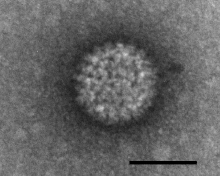| Orbivirus | |
|---|---|

| |
| Cryo-EM of the protein structure of a bluetongue virus capsid | |

| |
| Negatively stained Bluetongue virus–like particle that caused a cytopathic effect in BHK-21 cells. Scale bar = 50 nm | |
| Virus classification | |
| (unranked): | Virus |
| Realm: | Riboviria |
| Kingdom: | Orthornavirae |
| Phylum: | Duplornaviricota |
| Class: | Resentoviricetes |
| Order: | Reovirales |
| Family: | Sedoreoviridae |
| Subfamily: | Sedoreovirinae |
| Genus: | Orbivirus |
Orbivirus is a genus of double-stranded RNA viruses in the family Reoviridae and subfamily Sedoreovirinae. Unlike other reoviruses, orbiviruses are arboviruses. They can infect and replicate within a wide range of arthropod and vertebrate hosts. Orbiviruses are named after their characteristic doughnut-shaped capsomers (orbis in Latin means ring).
Many orbiviruses are transmitted by ticks or haematophagus insect vectors (Culicoides, mosquitoes and sand flies) and have a wide host range that includes cattle, goats and sheep, wild ruminants, equids, camelids, marsupials, sloths, bats, birds, large canine and feline carnivores, and humans.
The three economically most important orbiviruses are Bluetongue virus, African horse sickness virus, and Epizootic hemorrhagic disease virus, all of which are transmitted by Culicoides species. The genus contains 22 species and at least 130 different serotypes.[1][2]
- ^ "Virus Taxonomy: 2020 Release". International Committee on Taxonomy of Viruses (ICTV). March 2021. Retrieved 13 May 2021.
- ^ "Viral Zone". ExPASy. Retrieved 15 June 2015.